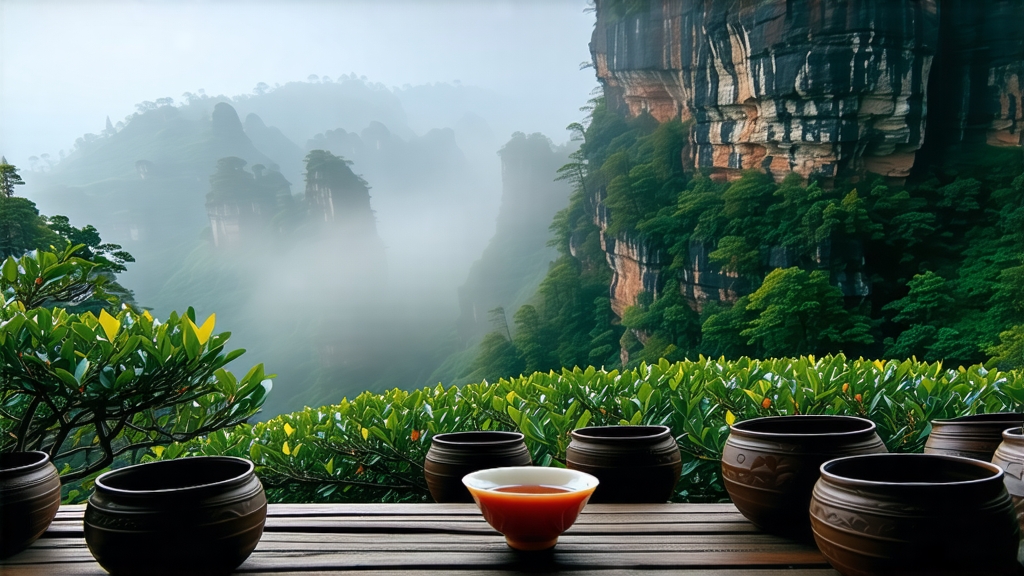
If green tea is the youthful scholar of Chinese tea and pu-erh the venerable sage, then Da Hong Pao—literally “Big Red Robe”—is the crowned prince: noble, dramatic, and endlessly complex. Nestled in the mist-locked Wuyi Mountains of northern Fujian, this oolong commands prices higher than gold when auctioned from the mother trees that still cling to the nearly vertical cliff faces of Jiulongke. Yet beyond the legend and luxury lies a living craft, a sensory language of “rock rhyme,” and a daily ritual that farmers, poets, and now global tea lovers share over tiny porcelain cups.
Legend first: during the Ming dynasty an imperial scholar, en route to the capital for the civil-service exam, fell ill at the foot of Wuyi’s cliffs. Monks from the nearby Tianxin Temple brewed leaves picked from six stunted bushes overhead; the scholar revived, passed the exam, and returned in triumph to drape his crimson robe over the bushes in gratitude. The Emperor, hearing the tale, declared the tea a royal tribute, and the name Da Hong Pao was sealed. Historians debate the chronology, but tax records from 1385 do list “Yancha” (cliff tea) among imperial levies, lending credence to the story’s core.
Taxonomy comes next. Da Hong Pao belongs to the Wuyi Yancha family, the strip-style oolongs baked over charcoal until their edges curl like ancient parchment. Within that family it is both a cultivar—originally the Qi Dan and Bei Dou genetic lines traced to the mother trees—and a proprietary blend. Today 99 % of what is sold as Da Hong Pao is a skillful marriage of three to five compatible bushes (often Rou Gui for spice, Shui Xian for orchid depth, and Qi Dan for mineral backbone) designed to echo the “mother tree” cup profile. Protected-origin rules stipulate that only leaf picked within the 60 km² Wuyi scenic reserve can bear the name, and even then must pass strict sensory evaluation for “rock rhyme,” the elusive yan yun that manifests as a cooling menthol finish, a stony echo that arrives minutes after swallowing, and a texture so smooth it feels like sipping liquid jade.
Crafting Da Hong Pao is a four-season conversation between human and leaf. Picking occurs only in late April, when three half-mature leaves still cup a dew-bright bud. The pluck is spread on bamboo trays to wither under the mountain’s morning sun, then tumbled in huge wicker drums to bruise the edges just enough for partial oxidation. What follows is the most critical step: charcoal roasting inside squat brick kilns fueled by locally harvested lychee wood. Masters like 73-year-old Liu Guoying sleep beside the kilns in four-hour shifts, adjusting the depth of ash, the gap between trays, and the scent rising from the leaves. A light “fire” (80 °C for 6 h) preserves floral notes; a heavy “foot fire” (120 °C for 20 h) deepens cocoa and toasted nut tones. Between roastings the tea rests in earthen jars for 30–45 days so moisture migrates outward evenly; the cycle may repeat two to four times. When finished, the leaf loses 30 % of its weight yet gains decades of aging potential.
To brew Da Hong Pao well, think of the gaiwan as a miniature mountain gorge. Pre-heat the lidded bowl until too hot to touch, then fill one-third with 6 g of twisted leaf. The first infusion is a flash rinse—water just off the boil poured in a high, thin stream to “wake the cliffs,” then discarded within three seconds. Subsequent steeps lengthen like shadows at dusk: 5 s, 10 s, 15 s, adding five seconds each round. Use spring water low in minerals; hard water flattens the yan yun into dull chalk. The liquor should bloom from pale apricot to deep mahogany by the fourth infusion, releasing aromas that shift from roasted apricot to tuberose, then to wet slate and finally to brown sugar. A good leaf yields twelve infusions; a great one, twenty.
Tasting is a choreography of tongue, breath, and imagination. Take a sip no larger than a tablespoon, hold it under the tongue for three heartbeats, then open the mouth slightly to draw cool air across the liquor. The initial attack